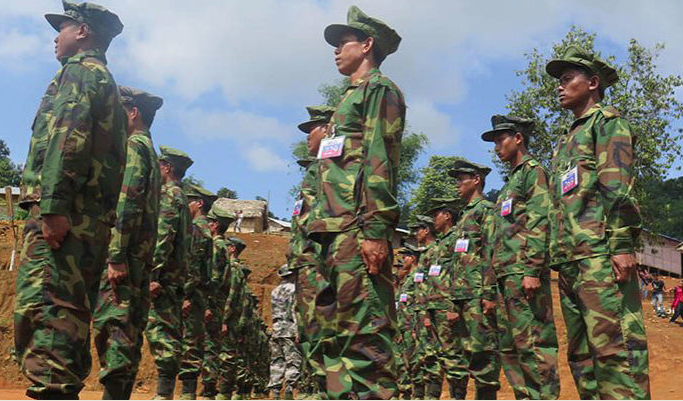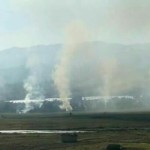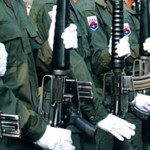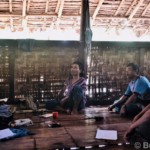By Nan Lwin Hnin Pwint/The Irrawaddy | November 14, 2017
In an interview with The Irrawaddy, a spokesman for the Arakan Army (AA) has claimed the group was defending its territory during an attack on a vessel that killed at least 11 Myanmar Army troops in Chin State last week. The army has described the attack as an ambush.
At least 11 Myanmar Army troops were killed and 14 wounded during a clash with the AA in the western township of Paletwa in Chin State.
The troops of the Tatmadaw, Myanmar’s military, were ambushed while traveling by boat along the Kaladan River, which flows into Myanmar from eastern India and runs through Chin and Rakhine states. A university student on board the vessel was killed in the attack and three women traveling with the group were injured, according to local sources.
Paletwa is an ethnic Chin township that borders Rakhine State. The AA uses the area as a base, crossing the Kaladan River to enter Rakhine.
Fighting between the two sides has escalated since the first week of November, forcing over 300 villagers from their homes. The AA said in a statement on Nov. 5 that the Tatmadaw had stepped up its offensive activities in the area and warned people to avoid unnecessary travel.
The AA is a member of the Wa-led Federal Political Negotiation and Consultative Committee (FPNCC), which has called for political negotiations with the government outside the NCA (Nationwide Ceasefire Agreement) framework.
The Tatmadaw, however, considers the AA an insurgent organization threatening the country’s sovereignty, and has refused to hold talks with it.
U Khaing Thu Kha, an information officer for the AA, recently talked to The Irrawaddy’s senior reporter Nan Lwin Hnin Pwint about the clashes in Paletwa.
What is the latest information you have regarding the clashes in Paletwa?
The most recent clashes occurred from Nov. 1 to Nov. 10 in the upstream areas of the Kaladan River. There were fierce clashes on Nov. 7 and 8. The Myanmar military has been launching large-scale attacks in the areas we control. The clashes erupted when they attempted to penetrate our strongholds.
How many locations have seen fighting so far?
Three or four. In the Maung Bu and Saman Talan mountain ranges, the military hit us with heavy guns day and night. They also brought in reinforcements around the mouth of Kalet Creek, which led to fighting. There were also clashes near Nom Bu village. On Nov. 8 near Nom Bu, hundreds of Tatmadaw troops arrived in three vessels, and our special combat forces intercepted them. During the attack, the Tatmadaw suffered heavy casualties and many wounded.
Which AA battalion fought with the Tatmadaw?
The clashes broke out when they advanced into an area controlled by our Brigade No. 3.
The Tatmadaw says its troops were ambushed, but the AA says the fighting started when Tatmadaw troops entered an AA-controlled area. What is your response?
The answer is simple. We’re not attacking their military bases; we have been defending ourselves against large-scale attacks on our bases. With peace being discussed, the Tatmadaw should not be launching serious attacks against armed ethnic groups. The government should seek to negotiate from an honorable position. Military destruction
How many casualties did the AA suffer in the Paletwa clash?
A few fighters were wounded; we have not sustained heavy casualties so far.
In its Nov. 5 statement, the AA urged local people to resist human rights violations by the Tatmadaw. But Paletwa locals told me they disliked AA because it had planted land mines, forced them to work and seized their cattle since entering the area. How do you explain this contradiction?
We’ve told locals that if our troops kill their livestock without paying them, we will compensate them twice the value of the cattle. On a previous occasion when clashes occurred, we did have to slaughter villagers’ cattle because we were short of food. But we paid them double compensation.
In some cases, Myanmar troops pretend to be AA fighters and seize cattle. This is common practice for the Tatmadaw. We never do things that burden local people. But the Myanmar Army does, and has been forcing villagers in and around Nom Bu to do physical labor.
Do the recent clashes pose a threat to the peace talks between the two sides?
We always keep the door open for peace. The fate of the peace talks rests entirely with the Myanmar Army. They are using force to fight their compatriots while chanting “annihilation.” But we always seek to solve political problems though political negotiations.
Regarding the allegations on social media that AA is killing civilians, this is just Tatmadaw propaganda.
A student was killed and three women injured in our attack on the Tatmadaw’s Light Infantry Battalion 563 near Nom Bu on Nov. 8 because they were on board a military vessel carrying food supplies.
The owner of the vessel, Aye Shwe, is married to a lieutenant in the Myanmar Army. That vessel is owned by them, and it is a military vessel. But some people said a civilian vessel had been attacked.
We issued a notice on Nov. 5 warning civilians to avoid traveling along the Kaladan River and the Kaletchaung and Pe creeks. It was not a civilian vessel, but a military vessel; they were on board and we attacked.
This interview originally appeared on The Irrawaddy on November 14, 2017







